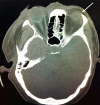Poor Outcome in Camel-Related Eye Trauma with Ruptured Globe
- PMID: 33854383
- PMCID: PMC8039017
- DOI: 10.2147/IMCRJ.S305158
Poor Outcome in Camel-Related Eye Trauma with Ruptured Globe
Abstract
Purpose: To report the poor visual outcome of ruptured globe caused by camel bites.
Observations: A 48-year-old camel caregiver presented to the emergency department after being bitten by a camel in the left side of his face. Ophthalmic examination revealed a superior scleral wound from 9 to 2 o'clock, about 6 mm from the limbus extending to the equator with prolapse of uveal and vitreous tissues, an opaque cornea, total hyphema, diffuse subconjunctival hemorrhage, and a lower lid laceration involving the lid margin and the nasolacrimal duct. The patient has undergone surgical repairs of ruptured globe and lid laceration, followed by retinal detachment surgery. Following these surgical interventions, the patient preserved a light perception vision with flat retina.
Conclusion: Camel-related injuries might primarily involve the ophthalmic structures, especially in camel bites. Camel-related eye trauma might lead to poor visual and anatomical outcomes which might not improve following surgical interventions.
Keywords: animal-related injury; camel attack; camel-related injury; retinal detachment; ruptured globe; trauma.
© 2021 Albazei et al.
Conflict of interest statement
All authors report no conflicts of interest in this work.
Figures



References
Publication types
LinkOut - more resources
Full Text Sources
Other Literature Sources

